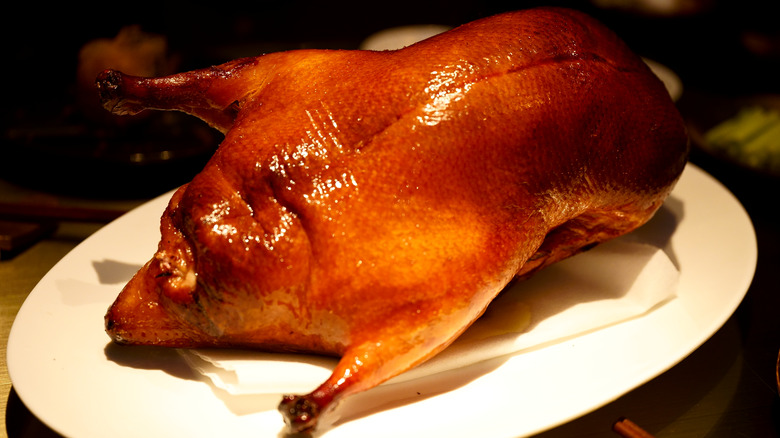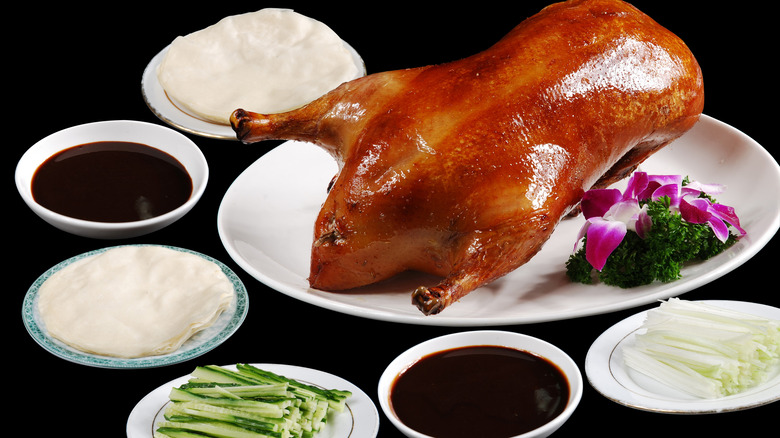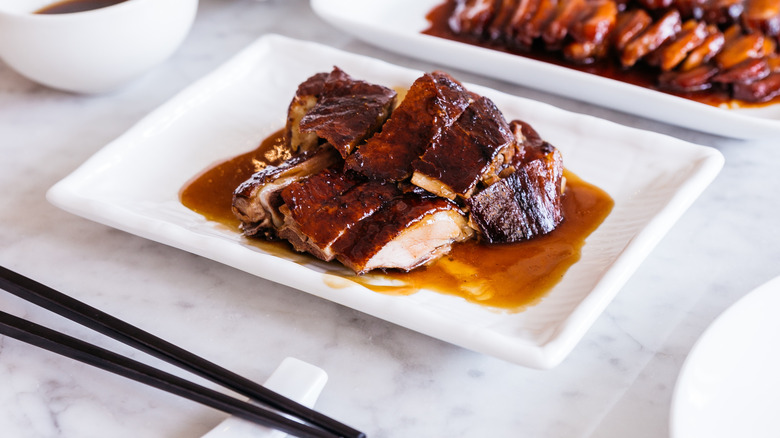The Difference Between Cantonese Roast Duck And Peking Duck
Duck is a tasty, perennial favourite for Chinese food fans. And even if, as The New York Times points out, it isn't exactly "common fare in China," every regional cuisine will have a distinct way of cooking and serving up this favored fowl, from roasting and steaming with orange peel and serving it up in a rich, aromatic soup to smoking it with an aromatic elixir of green tea and camphor wood.
National Geographic says that most duck dishes in Chinese cuisine originate from the watery regions bordering Shanghai, where the bird can be found, and roast duck is no exception. The dish was first spotted during the 13th century in Hangzhou, located about 100 miles away from Shanghai. The dish was first described as one first prepared by street vendors. During that time, ducks were said to be "roasted on a large metal fork over an open fire." The cooking method apparently caught on in Nanjing, which at the time was the imperial capital of China, and the ducks became known as "Jinling roast duck." It was only when the Yongle emperor decided to relocate to Beijing that the dish became synonymous with the city.
There are several ways to roast duck in Chinese cooking today. But these ducks aren't roasted in western style-ovens; they are either prepared in open ovens fitted with a brick fireplace, or closed ovens which resemble large iron barrels (via Michelin). Either way, both methods turn out a roast duck whose flavors linger long after the meal has passed.
How is Peking duck is prepared?
National Geographic says preparing ducks for roasting Peking-style begins even before they are cooked. Only white ducks are used to make this dish, and once they are dressed, air is forced into the space between the skin and the flesh to keep its skin looking plump. Its guts are then pulled out through a cut made beneath a wing to ensure that the skin is kept whole.
From there, "[peking] duck is wind-dried and painted with maltose syrup to help colour it a rich mahogany," while boiling water is used to bathe the bird's cavity, after which it is roasted until the skin is a slick, crisp golden brown. Unlike most roast ducks or chickens, Michelin notes that Peking duck is not stuffed with any herbs or spice mixes to keep its flavor as pure as possible. All told, Hong Kong Greeters adds that three days are needed to prep and cook a Peking duck.
Peking — or Beijing roast — duck begins as a feast for the eyes. At specialty restaurants, the duck is presented to diners in much the same way a prized bottle of wine might be, before it is carved, table-side, into 120 thin slices of skin, then of what National Geographic refers to as "half moon slices" of skin with meat, which is consumed on pancakes with sweet bean or hoisin sauce, leek, and cucumber (via SCMP). Leftovers are then cooked up with vegetables, and its bones are made into a delicious soup with cabbage or winter melon.
How is Cantonese roast duck prepared?
Cantonese roast ducks are served with far less ceremony, although they are prepared with slightly more fuss. These ducks are sliced at the abdomen, so their innards are removed; cavities are then filled with herbs and spices that include star anise, ginger, and spring onion, so that the ducks are bursting with flavor (via Michelin). From there, the abdomens are sewn shut and the ducks are boiled to help tighten the skin, and like their northern cousins, Cantonese ducks are dried before they are roasted in a hot oven.
While that might sound like a lot, too, preparing a roast duck Cantonese style definitely takes less time. Hong Kong Greeters says it only takes a seasoned chef about eight hours to get a duck from kitchen to the table. This dish is almost always enjoyed as a topping with fluffy white rice and parboiled greens.
There is a third type of roast duck that has made an appearance in the Chinese dining scene, and which has been often confused with the straightforward Cantonese-style roast ducks because of the spices in which the fowl is cooked. The pipa duck, named after a Chinese stringed instrument which is shaped like a lute, is a spatchcocked duck which is then brined in orange peels before it is air-dried and roasted in low temperatures, to ensure that its flesh remains juicy and tender. And like its Cantonese cousin, pipa ducks are quickly bathed in hot oil to ensure its skin is crisped up (via GMA News).


